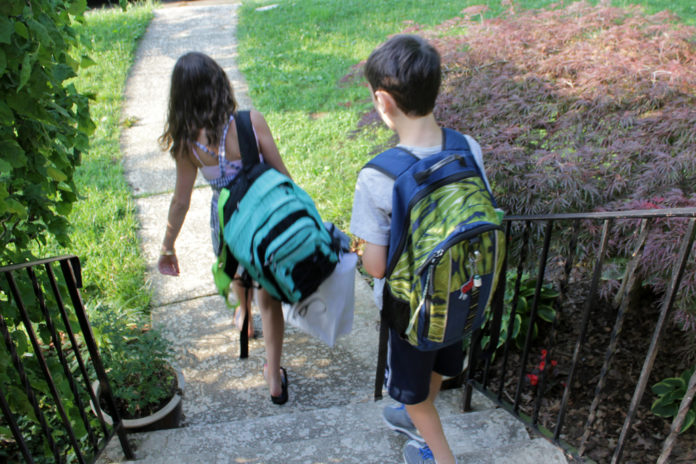
As summer winds down and you have your last hoorahs at the State Fair or one last jump in the pool, fall slowly encroaches and with that comes ‘back to school.’ You want your kiddos to be prepared and have each notebook, textbook, and binder packed and ready to go. I recall running off to school frequently heaving my backpack, slung over one shoulder in a futile attempt of casual coolness, jamming it packed with books, papers, and of course, extra snacks. But what I didn’t realize, and what you may overlook in the hustle to get the kids out the door, is how all those supplies piled in their backpacks could be causing unintended pain in your child’s shoulders and back.
“Heavy loads carried by more than 79 million students across the U.S. can cause low back pain that often lasts through adulthood,” asserts Karen Jacobs Boston University Clinical Professor of Occupational Therapy and spokeswoman for the American Occupational Therapy Association (AOTA).
Your kids have enough to focus on without the added stress of backpack induced back pain, soreness, and muscle fatigue. Fortunately, with a few changes and a little awareness, your child can easily avoid unnecessary pain and discomfort.
Choosing a backpack
When selecting a backpack AOTA recommends picking a lightweight fabric like canvas or nylon instead of leather. Look for adjustable padded shoulder straps, a padded back, multiple spread out compartments, and ideally a hip belt.
Once you’ve decided on a backpack make sure your child tries it on and is able to adjust the straps so it fits snugly against her back and doesn’t drop below the top of the hip bones. And as cool as I thought I looked rocking the one shoulder strap, my back and posture suffered. Always wear both straps and utilize the hip belt to take additional stress and weight off the shoulders and back.
Your child’s backpack should weigh no more than 10% of his or her weight.
While this may seem like an impossible task with all the supplies and devices your child needs, consider carrying heavier electronic devices in a separate bag, bringing empty, rather than filled, water bottles to then fill at school, as well as carrying only those books needed and opting instead for more frequent trips to his or her locker.
How to pack a backpack
Just as important as deciding what to put in your backpack, is how you pack your backpack. For the least amount of stress on your child’s back, pack heavier items closer to the back and center of the backpack while lighter items should be placed in the front of the backpack. Be sure to take advantage of all the different compartments and pockets to help disperse the weight. It is also beneficial for your kids to adopt the habit of a weekly cleanout of their backpacks to get rid of any extraneous items bound to accumulate throughout the week.
Warning signs
Even with these preventative measures, you should still watch for warning signs that your child’s backpack is too heavy. Some indications include if your child struggles to put on or take off the backpack, hunches and leans forward with the pack on, or if you notice red marks on his or her shoulders left by the backpack’s straps. You can also be proactive by asking your child if they’re experiencing any back pain or numbness or tingling in their arms or legs when wearing the backpack.
By following these tips you can easily prevent your child from incurring any injuries or developing chronic back pain. You’ll set your kids up for success so they can focus on school and not the weight on their backs.
















